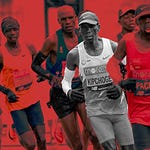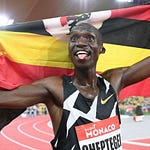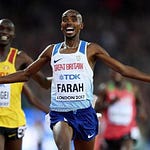Sundays are for a longer effort, so we’re going to feature a single longform essay or feature for you to dig in to. We’re calling it the Sunday Long Read. It’ll show up early, ready to be read as you prep for your run.
But first, we’ve embedded the latest episode of The XC Podcast👆, which features a conversation with Shannon Kennedy. Shannon wrote a guest essay for us last week entitled, “I was one of those young “phenom” girls.” In it, she describes her reaction to Mary Cain’s story, as Kennedy was also a top-level runner as a child, and has subsequently left the sport. The podcast expands upon her experiences, and she makes suggestions on how we can ensure that the next generation of girls find balance, success and happiness in running.
If you haven’t read her piece, you can find it here.
Below, we have a contribution from new teammate Caela Fenton. In it she looks at what could be next with this important discussion. Please do share this newsletter—it’s as easy as forwarding this email.
Thanks for reading.

By Caela Fenton
I imagine pretty much every woman who runs has been thinking a lot about Mary Cain’s words over these past couple of weeks. I certainly have. I’m a life-long runner who is doing PhD work at the University of Oregon—the birthplace of the first great running boom and the inception point for Nike. In many ways, it’s where our modern idea of running was created—both as a subculture and as a highly profitable industry. It’s also the very same institution that helped mold many within the Nike Oregon Project—Galen Rupp, Jordan Hasay, and of course its creator Alberto Salazar. Until recently, I’d see a lot of the NOP skull-and-wings logos running around campus. During my time in Eugene, I’ve been studying the intersection of literature and sport, specifically related to women’s running. So Mary Cain has been on my mind.
Also like pretty much everyone else, I’ve been trying to figure out how to best help forward this discussion. Is it by adding my voice to the group of runners, emboldened by Cain, who are talking about their disordered eating, amenorrhea, stress fractures and osteopenia? There are a lot of people who competed at much higher levels than I ever did, who are stepping forward right now. And while I’m happy to add my voice to theirs (and I will speak frankly about my personal experiences later on) it wasn’t a coach, or a specific program that put me in that situation. I’ve come to realize it’s something much bigger than that.
In an op-ed for the New York Times building on what Cain had to say, Lauren Fleshmen, a retired elite runner and entrepreneur wrote:
“Women and girls are no longer content just to have a chance to play; we are demanding that sports be rebuilt altogether.”
Our sports systems were designed by men, for men. Remember, the women’s marathon was not even an Olympic event until 1984. By contrast, the modern marathon is 123 years old, and of course men have raced marathon-like events since, well, at least that moment from which the word is derived. And there are holdouts for prejudice against systemic change—just look at the recent debate over equal cross-country distances as an example of that resistance.
Fleshman also notes how the linear trajectory of male progression in sport is often foisted upon young women, whose bodies are going through a different type of hormonal change during puberty. This is phrased quite succinctly in Dr. Stacey T Simms’ book, Roar: “Women are not small men.” Yet, training programs are often designed as if we are, and coaches often treat us as if we are. This is partly due (and again, this demonstrates the breadth of the system) to the fact that most research focused on performance use male test subjects and then assume the findings will apply to both men and women.
RED-S (formerly known as the Female Athlete Triad, but renamed to acknowledge men are also at risk), which stands for Relative Energy Deficiency in Sport, has become more of a focus of study, and I think more healthcare providers are finally becoming aware of it. When I lost my period for over a year in high school, my mother was rightfully concerned about my bone health and took me to the doctor. I was told that I should probably gain a bit of weight and was also put on birth control. I’m confident that this was considered best practice at the time, but in a lot of ways, it allowed me to live in denial of the fact that I wasn’t fuelling myself properly, and that there were bigger cultural issues weighing down on me.
Women, on the whole, are bombarded with media that tells us that we should lose weight. As Jen Ator of Women’s Running wrote last week, we’re about to enter the season where lots of headlines start to read: “How to avoid gaining weight during Christmas party season!,” which of course is the partner in crime with “Start working on your summer body now!” or “Abs by bikini season!”




Yes, weight is frequently framed within the sport as a performance metric (though see exercise physiologist Trent Stellingworth’s wonderful takedown of this idea and a list of what’s more useful to measure than a number on the scale), but this focus on weight in running also exists within a matrix of what an idealized woman’s body is supposed to look like. In the past weeks, there’s been even more of an outcry from women athletes whose supposedly “atypical” body shape has been remarked on in the press regarding their performance as somehow an anomaly or “not a typical runner’s body.”
When I developed disordered eating patterns, it had nothing to do with running. In fact, I hadn’t really started taking running very seriously yet. It started because I made a New Year’s resolution to “be healthier,” which to my 14-year-old self, meant giving up ice cream while a part of a family of very active individuals (and also avid ice cream eaters). Where did I pick up the idea that one couldn’t be “healthy” and eat ice cream? It certainly wasn’t from my parents and it wasn’t from any of my coaches at the time.
“I’d grown up thinking that this was something you didn’t talk about with anyone except your mom, or maybe close girlfriends.”
If losing weight is something that women are constantly told to do, we should also consider the flip side of this—we’re also made to feel that we shouldn’t ever talk about our menstrual cycle and our hormonal health. It’s one thing to say that coaches should be talking to their athletes about this, but also young girls need to grow up knowing that this isn’t a taboo subject. When I entered a university level cross-country program, I distinctly remember my coach, a middle-aged guy named Steve Boyd, asking me if my periods were regular. I was taken aback by the question. I’d grown up thinking that this was something you didn’t talk about with anyone except your mom, or maybe close girlfriends. I look back at that moment now and can see it as him being a coach carefully attuned to factors that would impact his women athletes, and wanting to ensure our longevity in the sport. It’s challenging for forward-thinking coaches if the athletes themselves feel embarrassed talking about their bodies. Maybe this is an argument for more women in coaching positions because young women athletes may feel more comfortable talking to them about these subjects. However, I think the ultimate goal should be that having a conversation about a missed period is no different than having a conversation about an achy hip or a sore foot, as a body communicating signs that training may need to be altered.
Mary Cain argues in her video that we need more women in positions of power in the sport—in athletic administration roles, in coaching roles (ups to Shalane Flanagan taking over the Bowerman TC). I strongly agree with her. In Canada, where I grew up, of the 26 teams competing at this year’s university cross-country championships, there is only one female head coach, with just 11 out of 26 staffing a woman in an assistant or managerial role (and I was generous here—if you had five coaches listed and one was a woman, I gave it to you). But, I think what Fleshman’s op-ed argues is that just slotting women into positions of power doesn’t guarantee a structural change if underlying systems are not addressed, or current modus operandi are not questioned. There are larger societal attitudes at play in this conversation—beyond the sport itself—that have ramifications for the sport.
Women’s bodies as a means to a financial end
We also can, and should, think of mistreatment of athletes as a labour issue.
Running has had a fraught relationship with professionalism. From the 1880s to the 1990s, track and field was a sport governed by amateur rules; the Amateur Athletic Union of the United States (AAU) was formed in 1888 and the International Amateur Athletics Federation (IAAF) was formed in 1912 (and didn’t change the “amateur” to “association” until just 2001). During this period, retaining amateur status (and therefore eligibility for the Olympics) meant that no athlete could receive any payment of any kind, from anyone, for anything related to sport. Doing so would risk a lifetime ban from the AAU. By the 1960s and 70s, several important factors came into play; the “Running Boom” led to a greater public presence and fanbase of the sport, shoe brands such as Nike and Adidas were growing and TV broadcasts of meets were creating opportunities for commercial profit off of athlete performances. It was at this point that historian Joseph Turrini describes as the formation of an “underground labor-relations system,” that is, amateur athletes began with more frequency accepting under-the-table deals from sponsors, often in order to put food on the table.
Among athletes, there was general discontentment with the fact that the AAU was pocketing the money from their performances, as well as dictating when and with whom they could compete. One of the most vocal was Steve Prefontaine, whose final race on the day of his death on May 29, 1975 at Hayward field against the Finnish national team was, in fact, an act of rebellion against the AAU.
By the early 1980s, the governing bodies were starting to rethink their approach to eligibility. Unwilling to wait for a final verdict from the IAAF, another important player took decisive action on the issue of paying athletes—Nike. At the Cascade Run Off in 1981, Nike openly and unapologetically offered prize money to winners, eligibility be damned. Running historian Roger Robinson has noted that at this point in history, Nike essentially forced the hand of the sport into a different arrangement of labour, into an era of not just professionalism, but commercialized professionalism:
“The Cascade Run Off revolt spurred or perhaps only hastened a necessary change. My regret is that the new arrangements were not more carefully thought through, and that we lost the process of global debate that had begun… I’m only suggesting that it would have been wiser for the sport as a whole, when professionalism began, to do more forward thinking, some sharing, and some investment in development.”
What Robinson is getting at here is that the transition to professionalism relied heavily on athlete sponsorship by commercial sporting good corporations, rather than a nationally-overseen and more social ideal—like the situation that Prefontaine admired in many of his European competitors. Robinson is also pointing out that no one thought ahead about how much control these corporations would be able to gain, or how and who would oversee them.
This lack of institutional control over oversight has today come to a head. The Mary Cain and the Nike maternity scandals earlier this year reveal that we’ve entered an austere new era for the elite runner, that could fittingly be dubbed Next% professionalism—a stage in which certain corporations can exert seemingly limitless control over athletes’ lives—telling them what to post on social media, compelling them to sign NDAs, and as Cain’s story so vividly tells, exert harmful pressure physically and mentally, with little or no oversight. Individual runners are tiny islands unto themselves, with little collective power. Women’s bodies are means to an end, and seen as interchangeable with men’s, and a pair of shoes reigns supreme over those who race in them.
I’ve seen rumblings on Twitter, but no definitive information about what labour-based organizing for track and field athletes would look like. This is not unprecedented in sport of course, everyone knows about the NBA, NFL, MLB and NHL have player’s associations to act as a collective bargaining unit. However, there are obvious differences in the way that these sports and track and field are organized. We’re witnessing a different, but related fight, being undertaken by the US Women’s Soccer Team for equal compensation with that of the men’s team. Their fight highlights another way that women are ostracized by the sporting community—the devaluing of female performance.
So where does that leave us?
My social media feeds over the last couple weeks have been gut-wrenching, but also incredibly empowering. I’m seeing more women speaking out than ever before, I think I’ve signed up for more newsletters, podcasts and mailing lists this week than I’ve ever subscribed to in my life (including Alison Wade’s Fast Women, Alysia Montaño, Molly Huddle and Roisin McGettigan’s Keeping Track and Lindsay Gibbs’ Power Plays). I’m incredibly thankful for Lindsay Crouse’s work in the New York Times. Men and women alike are eager to have this conversation and we need to keep that momentum going. The worst thing we can do is simplify this story to a single villian in Alberto Salazar.
We need to keep bringing the threads together in our sport and keep asking questions about who is wielding power, and for the benefit of whom? We need to keep asking questions about how they relate to broader contemporary issues: the #MeToo movement, economic globalization, pay equity, screen culture and the impact social media has on our mental health.
This is my first time writing for The XC. If you made it this far, thanks for reading. I hope, and am willing to work, to make our sport even better, and I hope you are too.













Share this post